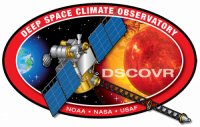DSCOVR (Deep Space Climate Observatory) is an American space weather station developed in partnership with NASA, NOAA, and the U.S. Air Force, that monitors changes in the solar wind, providing space weather alerts and forecasts for geomagnetic storms that could disrupt power grids, satellites, telecommunications, aviation, and GPS. DSCOVR orbits approximately 1.5 million km from Earth in a unique location called Lagrange point 1 (L1), the neutral gravity point between the Earth and Sun.
Instruments:
• Plasma-Magnetometer (PlasMag): Magnetometer and plasma sensor to measure solar wind properties for forecasting geomagnetic storms. The PlasMag instrument comprises a Faraday Cup (measures solar wind) and a Fluxgate Magnetometer, as well as two space weather instruments: the Electron Spectrometer and the Pulse Height Analyzer.
• Earth Polychromatic Imaging Camera (EPIC): Provides images ofthe sunlit side of Earth for science applications such as ozone, aerosols and clouds.
• National Institute of Standards and Technology Advanced Radiometer (NISTAR): Measures whole absolute irradiance integrated over the sunlit face of Earth for climate science applications.
